

2H4 Understand the concept of the magnification factor Q as applied to the voltages and currents in a resonant circuit.
The concept of Q is not easy to understand, but do not be put off by the name "Q" it is not a 007 special agent.
Let's liken Q to something that you can understand. If you deposited £100 in a bank and a week later returned to withdraw the money and received £200 you would say that the bank was rather good and that your money had been magnified by 2
Now if went you went back to the bank you received £1000 you would first think that the bank was fantastic and then may be that your £100 had been magnified by 10 or had a magnification factor of 10
This magnification factor is also known as Q so we could say that the Q factor of the bank was 10.
So let's go back into the world of amateur radio and consider Q and resonance.
Series Resonance
We have spoken about the reactance of the coil (inductor) which is like resistance but the coil still has "normal" resistance and for these calculations we call this RL and identify it in the circuit diagram as a resistor.
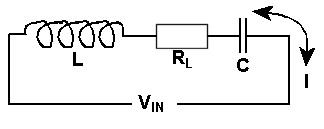
In this example let ![]() =
= ![]() = 10k,
= 10k, ![]() = 10R, and with
= 10R, and with ![]() = 10mV RMS at the resonant frequency.
= 10mV RMS at the resonant frequency.
as ![]() and
and ![]() cancel each other out, so from Ohm's law
cancel each other out, so from Ohm's law
![]() =
= ![]()
If you do not understand this then click here.
From the figures and the equation given above we have :-
![]() =
=
![]()
Thus ![]() =
= ![]() = 1 mA
= 1 mA
Voltage across ![]() or
or ![]() =
= ![]() x
x ![]() or
or ![]()
Thus Voltage across ![]() or
or
![]() =
= ![]()
Thus Voltage across ![]() or
or
![]() = 10 volts with only an input voltage of 10mV thus there is an apparent
"GAIN" in output volts.
= 10 volts with only an input voltage of 10mV thus there is an apparent
"GAIN" in output volts.
Gain
This "gain" between the input and the output is known as magnification factor which in this case = 1000 (10mV rising to 10V = 1000 times) and thus the
magnification factor at resonance = ![]() in this case 10k / 10 = 1000
in this case 10k / 10 = 1000
This magnification factor is given the name ![]()
Thus ![]() =
= ![]() or
or ![]() =
= 
![]() (Quality Factor)
(Quality Factor)
Parallel Resonance
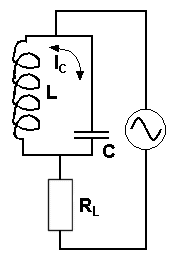
By varying the frequency of the input current, the
point where ![]() =
= ![]() approaches and a circulating
current
approaches and a circulating
current ![]() increases to a maximum in the parallel loop limited only
by
increases to a maximum in the parallel loop limited only
by ![]() . The voltage across the circuit
. The voltage across the circuit ![]() =
= ![]() x
x ![]() .
.
At the same time the overall resistance to the input current rises to a maximum and whilst the current through is at a minimum.
At resonance this parallel tuned circuit is called a rejecter circuit. Take another look at the graph above.
2H4 Recall that voltages and circulating currents in tuned circuits can be very high and understand the implications for component rating.
Currents flowing in tuned circuits can be greater than the input current due to what is called the "magnification factor" which is also known as "Q" and discussed above.
Similarly voltage too can be higher than the input voltage.
THERE ARE MANY VALUES OF INDUCTANCE AND CAPACITANCE THAT FORM A "RESONANT" CIRCUIT AND HIGH CIRCULATING CURRENT, FOR A GIVEN FREQUENCY.
IT IS THE L/C RATIO WHICH DETERMINES THE BANDWIDTH AND SELECTIVITY OF A TUNED CIRCUIT AND ITS DYNAMIC RESISTANCE.
Electronic components have what is called a "rating" and it is especially important that the rating is not exceeded else catastrophic failure of the component could occur and a domino effect occur which causes more damage than to the individually component.
Consider the trap dipole antenna and a high power being transmitted. FAILURE OF THE COMPONENTS can occur for two reasons:
2H4 Apply the formula for Q factor given circuit components values
The formulae are :- ![]() and
and ![]()
From the above ![]() =
= ![]() and we know that
and we know that ![]() thus
thus ![]()
Also from above ![]() =
=  and we know that
and we know that ![]() thus
thus
![]()
In all the formulae the following is true:-
![]() = frequency
in Hz,
= frequency
in Hz, ![]() = inductance in henries,
= inductance in henries, ![]() = capacitance in Farads
= capacitance in Farads ![]() = 3.142
= 3.142
so for a questions in the exam it is now just a matter of applying the formula to the variable given making sure that the correct multiplication factors are use as it is unlikely that you will be given the values of the variables as above but as milli henries and kHz or MHz and with the capacitors microfarads, so be prepared to do some manipulation.
2H4 Recall the definitions of the half power point and the shape factor of resonance curves.
The half power point is where the level of the response has
fallen to ![]() (0.707
or 70.7%) of the maximum response or the -3dB level.
(0.707
or 70.7%) of the maximum response or the -3dB level.
The shape factor is the ratio of the bandwidth at -60dB and -6dB
Assuming that we loosely couple a signal generator into the inductor of a parallel LC circuit and measure the voltage across with an RF voltmeter
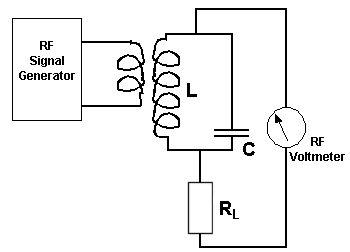
Now let us sweep the input frequency and draw graph of the resulting voltage changes.
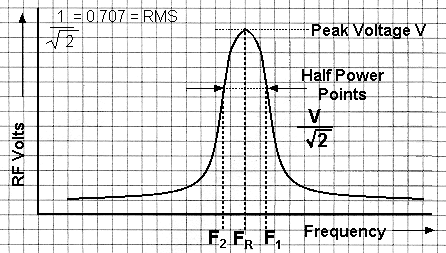
![]() is the resonant frequency giving a peak voltage,
is the resonant frequency giving a peak voltage, ![]() .
.
The points either side are generally accepted as limits of usable
frequency - This range ![]() to
to ![]() is the bandwidth [e.g.. 12kHz for speech] for a parallel LC circuit, which could
be the load in a power valve RF amplifier.
is the bandwidth [e.g.. 12kHz for speech] for a parallel LC circuit, which could
be the load in a power valve RF amplifier.
2H4 Apply the equation for Q given the resonant frequency and the half power points on the resonance curve.
The circuit above shows a parallel tuned circuit with an RF voltmeter, such as is used in a common form of Q meter. Q meters give a measure of "Goodness" of a component or circuit. From the above resonance chart we have the equation for the resonant frequency and half power points is :-
![]() =
= ![]()
which is also
the Bandwidth F1 & F2 compared to the resonant frequency FR = SELECTIVITY
Q of a Response Curve

If we had a response curve where the centre frequency FR was 10MHz and a band width of 200kHz (F1 - F2) what will be the "Q" of the circuit ?
![]() =
= ![]() =
= 
![]() =
= ![]()
2H5 Understand the meaning of dynamic resistance RD.
This expression, dynamic resistance is used in parallel tuned circuits of inductor, resistor and capacitor. When such a circuit is at its resonant frequency the tuned circuit can be represented entirely by resistance. This resistance is called dynamic impedance or dynamic resistance. This is an apparent resistance but exist with alternating current of the resonant frequency.
The parallel resistance of a tuned circuit at resonance is ![]() x
x ![]() .
This is known as the DYNAMIC resistance
.
This is known as the DYNAMIC resistance
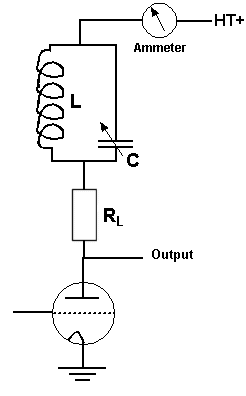
An example of this is shown, a parallel tuned circuit in the "ANODE" of a RF amplifier.
Let ![]() =
1000 Ohms
=
1000 Ohms
and ![]() =
100
=
100
To tune to resonance we adjust ![]() until the DYNAMIC RESISTANCE is
HIGHEST, i.e. for a max dip on the ammeter.
until the DYNAMIC RESISTANCE is
HIGHEST, i.e. for a max dip on the ammeter.
The coupling resistance to the next stage (Dynamic Resistance) is
![]() x
x ![]() = 100,000 Ohms
= 100,000 Ohms
The series RFresistance of the coil
= ![]() = 10Ohms
= 10Ohms
Apply the formula for RD given component values
The formula is :- ![]()
Thus at resonance in a parallel tuned circuit of L C & R, the
dynamic resistance RD can be calculate from the formula ![]() where L (the inductance) is in Henries, C (the capacitance) is in Farads,
and R (the resistance) is in ohms.
where L (the inductance) is in Henries, C (the capacitance) is in Farads,
and R (the resistance) is in ohms.
The general expression for Dynamic Resistance is :-
![]() =
= ![]() which does not include any frequency component.
which does not include any frequency component.
It is obvious from this that the larger ![]() compared to
compared to ![]() , the higher will be the Dynamic Resistance and
, the higher will be the Dynamic Resistance and
![]() .
.
So we can also express the Q factor using RD in this equation
![]()
Know the effect of damping resistors in a tuned circuit.
If we set a perfect tuned circuit into oscillation and then removed the source of the initial oscillation, it will carry on oscillating indefinitely. If then, we introduce some resistance into the circuit a little power is dissipated each cycle and the oscillation will die off exponentially. This loss of oscillation occurs whether the resistance is in parallel or in series with the tuned circuit. The resistance we have introduced is called DAMPING by damping resistor and reduces the Q-factor of a resonant circuit.
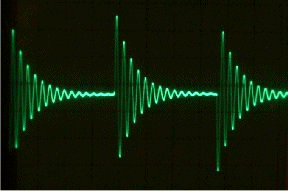
The picture above is of an actual oscilloscope trace where a tuned circuit is set in oscillation by a square wave which is superimposed on the trace just to show you where the square wave triggers the oscillation. Each sharp edge of the square wave causes the tuned circuit to oscillate and the damping effect of the imperfect tuned circuit is well shown. Note the shape of the curve of the reducing amplitude, the percentage of amplitude lost is the same for each per cycle hence the exponential curve.
NOTE: There is no such thing as a perfect tuned circuit so all circuits have some inherent damping which eventually stops their oscillation and such is the case with the tuned circuit pictured on the oscilloscope trace as it is the inherent damping of the inductor that caused the damping of the oscillations.
There are equations to calculate the equivalent series resistance caused by a parallel one but these are not required at this level.
Let's look at the real world situation an RF amplifier.
If we use a near perfect tuned circuit in an RF amplifier, once it is excited it s oscillations would die out very slowly and any modulation at the amplifier input would be lost in the tuned circuit, so we "DAMP" it to the point where the oscillation dies out much faster than any modulation waveform. This damping, by the way, reduces the Q.
Another definition of Q is the ratio of Energy stored / energy lost (per cycle)
The origin of some of the text on this page is from the RSGB with additions by the web master